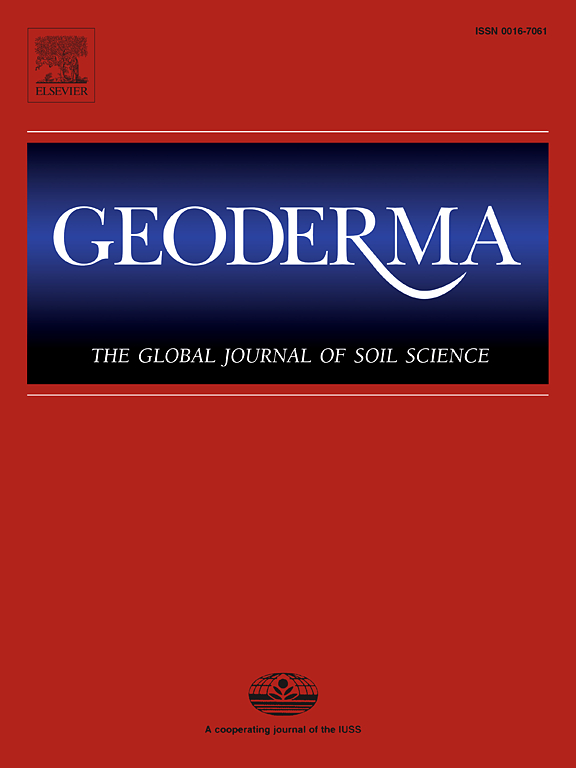A chronosequence of climosequences: The evolution of ecological soil thresholds in Hawaiian volcanic soils
IF 6.6
1区 农林科学
Q1 SOIL SCIENCE
引用次数: 0
Abstract
The soil-forming factors of climate and time directly influence mineral weathering, nutrient flow, and soil pedogenesis. Soil properties do not respond linearly to climate and time, but rather, follow a series of pedogenic thresholds that delimit soil process domains defined by dominant chemical buffer systems. These pedogenic thresholds relate to soil fertility and ecological gradients, although they are not equivalent due to differences in the dynamics between surface soils and the entire solum. Here, we identified thresholds in surface soils derived from Hawaiian substrates across gradients of water balance and soil substrate geologic age while controlling for other soil-forming factors (i.e., topography, biota, and parent material). We conducted extensive field sampling (n = 577) and analysis of soil properties, chiefly elemental analysis, pH, and exchangeable nutrients. With the use of previously published soil data (n = 285), we created a chronosequence (5, 15, 20, 120, 150, 450, 1,400, 4,100 ky) of eight climosequences. We statistically determined thresholds across each climosequence using four types of non-linear breakpoint analyses. We quantified thresholds delineating the exhaustion of primary minerals on all eight substrates and thresholds indicating the mobilization of iron on the three oldest soil substrates. Across the chronosequence, thresholds in surface soils shifted to drier climates (i.e., lower water balance values) as soil substrate age increased, following a highly predictable (R2 = 0.94) logarithmic decay function, with rapid evolution occurring in young soils and deceleration of change occurring in older soils. The youngest substrate (5 ky) did not follow this logarithmic pattern, which we hypothesize (based on previous studies) is due to surface area reactivity limitations. The pedogenesis of Hawaiian soils and the evolution of their ecological soil thresholds offer a well-behaved model system for broader implications regarding soils forming in more complex, continental settings.
气候序列的时间序列:夏威夷火山土壤生态土壤阈值的演化
气候和时间的成土因子直接影响矿物风化、养分流动和土壤成土作用。土壤性质不是对气候和时间的线性响应,而是遵循一系列的成土阈值,这些阈值划定了由主要化学缓冲系统定义的土壤过程域。这些成土阈值与土壤肥力和生态梯度有关,但由于表层土壤和整个土壤之间的动态差异,它们并不相等。在这里,我们在控制其他土壤形成因素(即地形、生物群和母质)的同时,确定了来自夏威夷基质的表层土壤的阈值,这些阈值跨越了水平衡和土壤基质地质年龄的梯度。我们进行了广泛的田间取样(n = 577)和土壤性质分析,主要是元素分析、pH值和交换性养分。利用先前发表的土壤数据(n = 285),我们创建了8个气候序列的时间序列(5,15,20,120,150,450,1,400,4,100 ky)。我们使用四种类型的非线性断点分析来统计确定每个高潮序列的阈值。我们量化了描述所有八种基质上初级矿物质枯竭的阈值和表明三种最古老土壤基质上铁动员的阈值。在整个时间序列中,表层土壤的阈值随着土壤基质年龄的增加而向干燥气候(即较低的水平衡值)转移,遵循一个高度可预测(R2 = 0.94)的对数衰减函数,在年轻土壤中发生快速演变,而在较老的土壤中发生减速。最年轻的底物(5ky)没有遵循这种对数模式,我们假设(基于先前的研究)是由于表面积反应性限制。夏威夷土壤的成土作用及其生态土壤阈值的演变为更复杂的大陆环境中土壤形成的更广泛的影响提供了一个良好的模型系统。
本文章由计算机程序翻译,如有差异,请以英文原文为准。
求助全文
约1分钟内获得全文
求助全文
来源期刊

Geoderma
农林科学-土壤科学
CiteScore
11.80
自引率
6.60%
发文量
597
审稿时长
58 days
期刊介绍:
Geoderma - the global journal of soil science - welcomes authors, readers and soil research from all parts of the world, encourages worldwide soil studies, and embraces all aspects of soil science and its associated pedagogy. The journal particularly welcomes interdisciplinary work focusing on dynamic soil processes and functions across space and time.
 求助内容:
求助内容: 应助结果提醒方式:
应助结果提醒方式:


